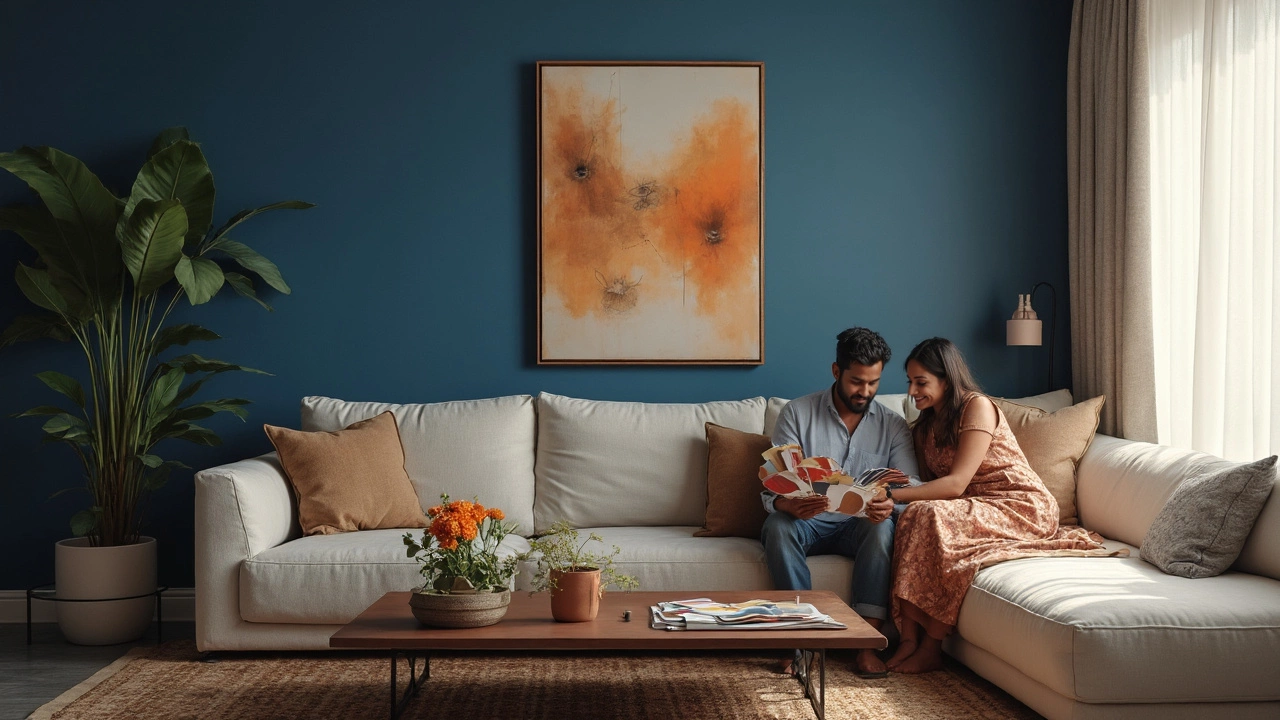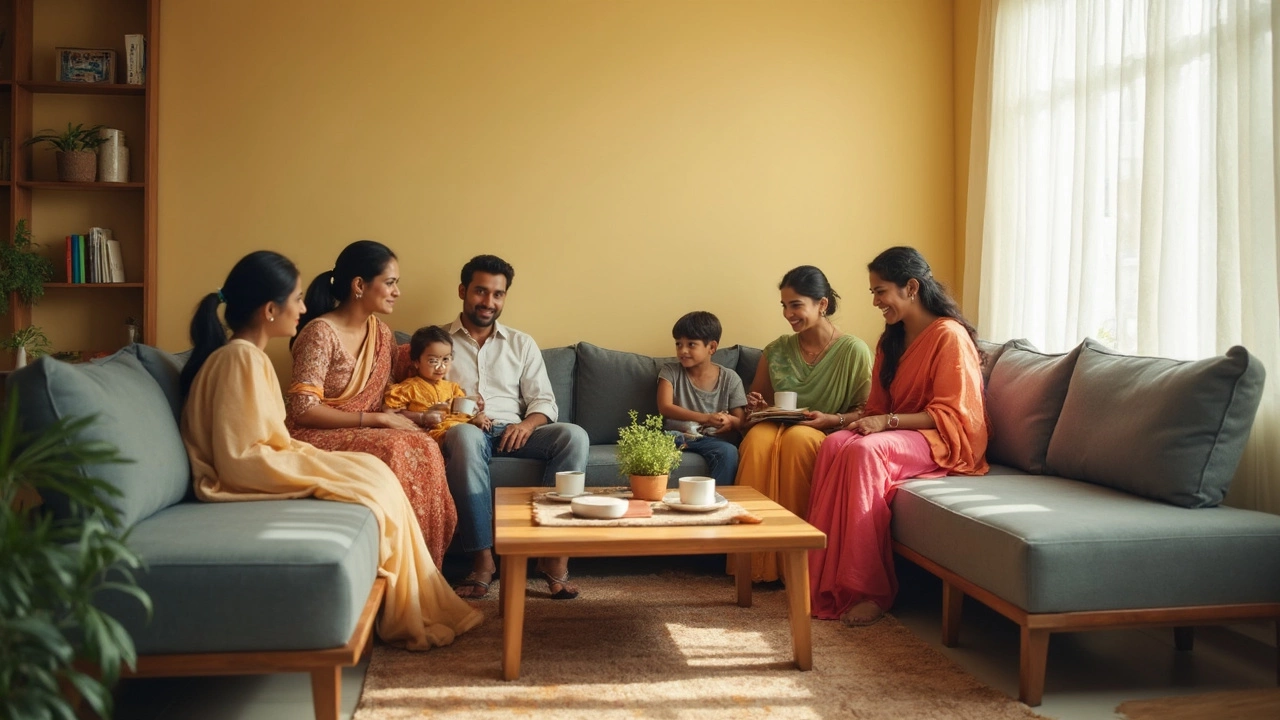Ever brought home a new couch, pushed it up against the wall, and stood back only to think… something just looks off? This happens more often than you’d think, especially when the wall color doesn’t play nice with your couch. Turns out, the whole vibe of your living room can shift depending on whether your walls are lighter or darker than your sofa. And yep, that includes how your coffee table looks in the mix.
Getting this right matters if you want a living space that feels put together instead of awkward. Lighter walls can make your room feel bigger and fresher, but a darker wall can ground the space or make your couch (and even your coffee table) pop. The trick is knowing what mood you actually want and what makes daily living easiest. After all, nobody wants a setup that only looks good on Instagram but feels weird in real life.
- Why Wall and Couch Colors Matter
- How Color Balance Impacts Your Coffee Table
- When to Choose Lighter Walls
- When to Go With Darker Walls
- Easy Ways to Test Before You Commit
Why Wall and Couch Colors Matter
Let’s get straight to it—your wall and couch colors totally change how your living room looks and feels. You might not notice it at first, but a color clash can make a place feel cramped, mismatched, or just plain blah. On the flip side, a strong color combo makes everything look intentional, even if you’ve got a wild cat like Whiskers knocking things off the coffee table.
Here’s why this actually matters: your couch usually takes up a good chunk of space and is often a main focus in the room. The walls are the biggest background canvas. Put them together right, and your room feels bigger, brighter, or more chill, depending on what you go for. Put them together wrong, and even your favorite couch can look out of place.
Some real numbers say a lot here. According to a 2023 home design survey by Houzz, 75% of homeowners who switched up their wall or sofa color said it made their furniture and décor feel more "pulled together" and the space felt cozier.
| Color Combo | Most Reported Effect |
|---|---|
| Lighter Walls + Dark Couch | Room feels bigger, couch stands out |
| Darker Walls + Light Couch | Cozy, dramatic, couch is the focus |
| Walls & Couch Similar Color | Calm, blended vibe but less impact |
You don’t just want a room that looks good online—you want it to work for your life. Messy pets? Dark couch, light walls. Love showing off a fancy coffee table? Make sure the background doesn’t steal the spotlight. Picking the right wall and sofa pairing is way more important than it seems at first.
How Color Balance Impacts Your Coffee Table
Most people don't realize it, but your wall and couch colors actually change how your coffee table looks and feels right in the living room. It's not just about whether the table matches the couch—a lot comes down to how light or dark things are in the whole area. Color balance can make your coffee table the cool center of attention or just a piece you barely notice.
If your couch and walls are the same color and depth—say, both light gray—the coffee table can totally blend in, especially if it’s also a similar shade. On the flip side, strong contrast makes things pop. For example, a light couch on a dark wall frames the sofa well, letting a wooden or glass coffee table stand out, rather than getting lost in the middle.
Check out this quick breakdown showing how combinations affect the coffee table’s vibe:
| Wall Color | Couch Color | Coffee Table Vibe |
|---|---|---|
| Lighter than couch | Dark | Table pops, feels like centerpiece |
| Darker than couch | Light | Couch gets focus, table more subtle |
| Same shade | Same shade | Table blends, not much contrast |
| Bold accent wall | Neutral | Table feels anchored, more dramatic |
Light walls generally make the space feel open, so even something bulky like a chunky wood coffee table doesn’t look too heavy. Dark walls, meanwhile, can shrink the visual space but make glass or metal tables look sharp and stylish. Want one more trick? Try to keep either the couch or table as the odd one out, shade-wise. If both are dark and moody, a lighter wall helps lift everything. Too much dark and your room starts feeling like a movie theater—cool for a night, less great for every day.
One interesting fact: The size and sunlight in your room make a difference. Bright rooms can handle darker walls and heavier tables, while smaller, dim spaces benefit from lighter colors to keep things feeling breezy. Also, people subconsciously spend more time around coffee tables that are easy to spot and look welcoming—no joke—it’s one of those little-known effects of color psychology.

When to Choose Lighter Walls
Lighter walls are a go-to if you want a room that feels open and bright, especially if your living area doesn’t get a ton of natural light. White, pale gray, or soft beige bounces whatever daylight you do get around the room. If you’ve got a dark or bold colored couch, lighter walls keep things from feeling heavy or closed in. Plus, lighter walls make most rooms look bigger, which is handy if your space is on the small side.
Here’s a cool fact: according to the American Lighting Association, rooms with white or very light walls reflect up to 80% of the light that hits them, compared to only 10-15% with deep colors. So if you hate dark corners or want coffee table displays to show up clearly, lighter is smarter.
- You’ve got a bold- or dark-colored couch. The contrast makes your furniture stand out, but not in a shouty way.
- Your room is small or doesn’t get much daylight. Lighter walls help fake a bigger, more airy vibe.
- You love changing up accent colors. Lighter backgrounds go with pretty much any art, throws, or seasonal coffee table setups.
If you’re into minimal cleaning (who isn’t?), lighter walls also make cat hair–looking at you, Whiskers–and dust less noticeable than dark colors. But watch out for grubby hands or food stains from snack-laden coffee tables, because stains show quicker on light paint.
Here’s a quick look at how wall color choice impacts your space:
| Wall Color | Light Reflection | Makes Room Feel |
|---|---|---|
| Lighter (white, pale gray) | High (about 80%) | Bigger, brighter |
| Darker (navy, deep green) | Low (10-15%) | Cozy, smaller |
So, if your couch is the star—or you just want to kick back in a breezy, sunlit setting—lighter walls are the way to go.
When to Go With Darker Walls
Darker walls don’t just look cool—they help create a cozy atmosphere, especially in living rooms where you want to chill and unwind. If you’re working with a light or neutral couch, darker walls can actually make that furniture shine. Think of a soft gray, navy, or even deep green wall behind a beige or light-gray couch. The contrast makes the couch feel more inviting, and the whole room ends up looking way more intentional.
If you’ve got a coffee table you want to show off, darker walls can act like a background curtain, pulling attention to your table and couch as the stars of the space. This trick works especially well if your table is a statement piece—like a funky glass top or a bold wood finish. Try it if you’re tired of everything blending together and want each piece to stand out.
Here are a few signs that darker walls might be your best move:
- Your space gets a ton of natural light. Sunlight keeps the room from feeling closed in, even with a rich, dark wall color.
- Your couch is on the lighter side. The contrast between light couch and deep walls looks pulled together and modern.
- You’re aiming for a vibe. Dark walls feel more intimate and upscale, a look you’ll see in popular design magazines this year.
- Your coffee table or decor either contrasts with or complements bold backgrounds—like white marble or chic brass legs against dark paint.
Keep in mind, though, if you have pets like my cat Whiskers, darker walls can hide minor scuffs or paw prints better than white ones. Plus, if you ever change your couch, darker backgrounds are usually pretty flexible with most colors and fabric styles.
Last tip: Before you get excited and buy gallons of paint, test patches on a few walls. Look at them with your lighting, around your couch, and how they play with your coffee table. Don’t trust tiny paint chips—they never tell the whole story!

Easy Ways to Test Before You Commit
Committing to a paint color is kind of a big deal, especially when your couch and coffee table are already in place. You probably don’t want to end up repainting in two weeks—or buying a new couch after realizing they clash. Lucky for us, it’s way easier to test out looks before you make anything permanent.
Start small by grabbing paint samples—those tiny cans usually cost less than a fancy coffee. Paint a big piece of poster board (about the size of your coffee table top), and tape it right behind your couch. Move it around as the light changes and see how the color looks in the morning, afternoon, and at night. This gives you a real sense of how the wall will play off your furniture instead of trying to guess from those tiny paint chips at the store.
Don’t forget about fabric samples, too. If you’re getting a new couch or thinking of swapping out your coffee table, most stores will hand over swatches if you ask. Lay them on your couch, drape them against the wall, or put them under your current lighting to spot any weird undertones or color clashes.
- Use free online room visualizers. Upload a pic of your actual living room and swap wall colors and furniture shades virtually. Brands like Sherwin-Williams, Benjamin Moore, and Home Depot offer these tools, so you can see your couch and coffee table with different wall shades before you do anything messy.
- If you want to go DIY, pile up throw blankets or bedsheets in the shade you’re thinking of, then pin or drape them behind the couch. It’s not glamorous, but it’ll give you an instant idea of what strong color would look like filling that whole wall.
- Ask for feedback. Snap a quick photo and send it to a friend who’ll be honest—or post it in a home decor group online. Sometimes, a fresh set of eyes spots stuff you miss (like how your coffee table blends in or stands out).
Bottom line: don’t rely on guesswork. Playing with samples, swatches, and digital tools is a lot faster and less stressful than a total redo. A little testing up front saves you from living with a wall color that makes you question every other piece of the room.

